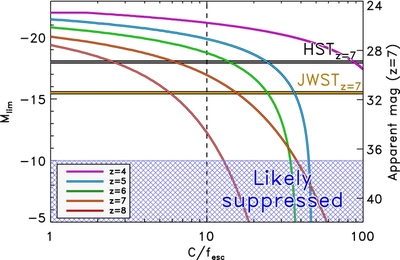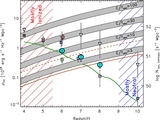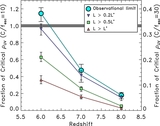Image Details

Caption: Figure 7.
Colored curves show the limiting UV absolute magnitude for different redshifts necessary to sustain reionization for a given ratio between the IGM clumping factor and the ionizing escape fraction. The hatched region denotes the magnitude range where star formation is likely to be suppressed via photo-heating from the sources which began the process of reionization at higher redshift. The dashed line shows our canonical model of a clumping factor of three and f esc = 30%, or C/ f esc = 10, which is a reasonable assumption for the conditions in the universe at z ⩾ 6. The horizontal gray bar denotes the limiting UV magnitude of HST observations of the HUDF at z = 7 ( m AB = 29). A hypothetical JWST deep field will reach 2.5 mag deeper to m AB = 31.5 or M UV = −15.5 (for z = 7). At z = 6, our observations (shown in Figure 3) already reveal a population of galaxies capable of sustaining reionization. At z = 7, the observed population is not bright enough to sustain reionization, thus if reionization completes at z > 6, fainter galaxies are necessary, which should be revealed by JWST. At z = 8, even JWST cannot image deep enough to see the hypothetical extremely faint population necessary to complete reionization at z = 8.
Copyright and Terms & Conditions
© 2012. The American Astronomical Society. All rights reserved.









